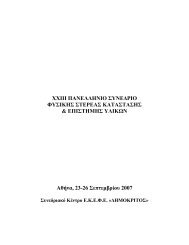NRC Annual Report 2001-2002
NRC Annual Report 2001-2002
NRC Annual Report 2001-2002
- No tags were found...
Create successful ePaper yourself
Turn your PDF publications into a flip-book with our unique Google optimized e-Paper software.
Advances in manufacturingCutting costs – reducing wearfor the resources sectorThe <strong>NRC</strong> Innovation Centre(<strong>NRC</strong>-IC) in Vancouver is helpingCanada’s resources sector cutcosts by reducing wear and tearon equipment. Working on behalfof the Mining Wear ResistanceMaterials Consortium – an affiliationof <strong>NRC</strong>, two universities andnine private firms from Australiaand Canada, including oil sandsgiant Syncrude, the researchersare unravelling the mysteries offriction and wear. This R&D has amajor impact, allowing firms thatmine the oil sands, for example,to cut their overall productionexpenses significantly.Image courtesy Syncrude Canada Ltd.D i s c o v e r yManufacturing remains one of Canada’s majoreconomic forces, touching virtually every sector ofthe economy. <strong>NRC</strong>’s R&D programs are targeted tohelp manufacturers increase their competitivenessand improve the commercial viability of productsand services. The programs also help manufacturerscreate and adapt to new technologies, materialsand processes, and meet their environmentalresponsibilities.Refining processes for food industriesResearchers at the <strong>NRC</strong> Institute for ChemicalProcesses and Environmental Technologies (<strong>NRC</strong>-ICPET) collaborated with Montréal-based ColarômeIncorporated, helping the company improve itsprocessing system for refining food grade coloursfrom vegetable extract. Process modificationsincluded replacing a biological processing stagewith a physico-chemical stage. The modifications,successfully implemented on-site, reduced thenumber of process stages, decreased processingtime by 33 percent, and improved product quality.Artificial cornea researchmoves forward<strong>NRC</strong>-ICPET researchers, workingin collaboration with theUniversity of Ottawa’s EyeInstitute and other partners, aredeveloping new biosyntheticpolymers for use in tissue engineered(TE) corneas. Thechallenge is to develop a familyof synthetic materials that canbe made into TE corneas strongenough for transplantation, transparent enough tomimic natural corneas, and resistant to biodegradationand rejection by the body’s immune system.So far, they have developed a series of biosyntheticpolymers that can be tolerated by living cell tissueand modified to improve the strength of thematerial and cell adhesion. They have advancedcell biology to the point where both nerve cell andblood vessel ingrowth were demonstrated. And, theteam has been successful in developing proceduresthat allow the production of transparent, collagenbasedpolymeric materials to produce artificialcorneas.19S C I E N C E A T W O R K F O R C A N A D A
















